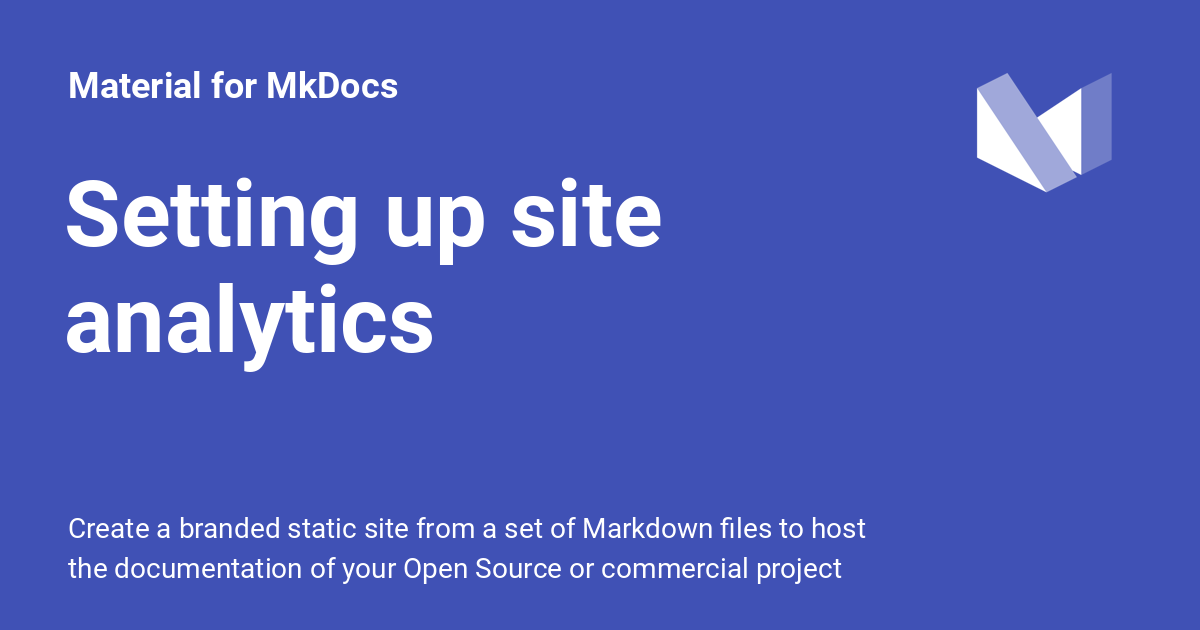Setting up social cards¶
Social cards, also known as social previews, are images that are displayed when a link to your project documentation is shared on social media. Material for MkDocs can generate beautiful social cards automatically, using the colors, fonts and logo1 defined in mkdocs.yml, e.g.:
The social preview image for the page on setting up site analytics. Twitter's Card validator shows how it will look when shared.
Configuration¶
Built-in social plugin¶
Sponsors only · insiders-2.12.0 · Plugin · Experimental
First, ensure you've installed all dependencies and have a valid site_url, as social preview images must be referenced via absolute URLs. Then, add the following lines to mkdocs.yml:
If you need to be able to build your documentation with and without Insiders, please refer to the built-in plugins section to learn how shared configurations help to achieve this.
The following configuration options are available:
cards-
Default:
true– This option specifies whether to generate social card images. If you want to switch the plugin off, e.g. for local builds, you can use an environment variable: cards_color-
insiders-2.13.0 · Default:
theme.palette.primary– This option specifies the colors for the backgroundfilland foregroundtextwhen generating the social card:- Colors can either be defined as HEX colors, or as CSS color keywords. Note that HEX colors must be enclosed in quotes.
cards_font-
insiders-4.3.0 · Default:
theme.font.text– This option specifies which font to use for rendering the social card, which can be any font hosted on Google Fonts: cards_dir-
Default:
assets/images/social– This option specifies where the generated social card images will be written to. It's normally not necessary to change this option:
Dependencies¶
Two Python packages are installed alongside Material for MkDocs to generate the social preview images, both of which are based on the Cairo Graphics library:
The Docker image for Insiders comes with all dependencies pre-installed. If you don't want to use Docker, see the following section which explains how to install all dependencies on your system:
Make sure Homebrew is installed, which is a modern package manager for macOS. Next, use the following command to install all necessary dependencies:
As stated in the installation guide, the easiest way to get up and running with the Cairo Graphics library on Windows is by installing GTK+, since it has Cairo as a dependency.
There are several package managers for Linux with varying availability per distribution. The installation guide explains how to install the Cairo Graphics library for your distribution:
Caching recommended¶
The built-in social plugin automatically fetches the fonts you define in mkdocs.yml from Google Fonts, and uses them to render the text that is displayed on the social card. The font files and generated cards are both written to the .cache directory, which is used in subsequent builds to detect whether the social cards need to be regenerated. You might want to:
- Ignore the
.cachedirectory in your project, by adding it to.gitignore. -
When building your site for publishing, use a build cache to save the
.cachedirectory in between builds. Taking the example from the publishing guide, add the following lines:name: ci on: push: branches: - master - main jobs: deploy: runs-on: ubuntu-latest steps: - uses: actions/checkout@v2 - uses: actions/setup-python@v2 with: python-version: 3.x - uses: actions/cache@v2 with: key: ${{ github.ref }} path: .cache - run: pip install mkdocs-material - run: mkdocs gh-deploy --force
Meta tags¶
The built-in social plugin automatically sets all necessary meta tags, equivalent to the following two customizations, which you can set manually when you don't want to use it:
{% extends "base.html" %}
{% block extrahead %}
{% set title = config.site_name %}
{% if page and page.meta and page.meta.title %}
{% set title = title ~ " - " ~ page.meta.title %}
{% elif page and page.title and not page.is_homepage %}
{% set title = title ~ " - " ~ page.title %}
{% endif %}
<meta property="og:type" content="website" />
<meta property="og:title" content="{{ title }}" />
<meta property="og:description" content="{{ config.site_description }}" />
<meta property="og:url" content="{{ page.canonical_url }}" />
<meta property="og:image" content="<url>" />
<meta property="og:image:type" content="image/png" />
<meta property="og:image:width" content="1200" />
<meta property="og:image:height" content="630" />
{% endblock %}
{% extends "base.html" %}
{% block extrahead %}
{% set title = config.site_name %}
{% if page and page.meta and page.meta.title %}
{% set title = title ~ " - " ~ page.meta.title %}
{% elif page and page.title and not page.is_homepage %}
{% set title = title ~ " - " ~ page.title %}
{% endif %}
<meta name="twitter:card" content="summary_large_image" />
<meta name="twitter:title" content="{{ title }}" />
<meta name="twitter:description" content="{{ config.site_description }}" />
<meta name="twitter:image" content="<url>" />
{% endblock %}
Usage¶
If you want to adjust the title or set a custom description for the social card, you can use the Metadata extension, which takes precedence over the default values.
-
Both types of logos, images (
theme.logo) and icons (theme.icon.logo) are supported. While an image logo is used as-is, icons are filled with the color used in the header (white or black), which depends on the primary color. ↩
